Prioritization and Optimal Location of Hydrogen Fueling Stations in Seoul: Using Multi-Standard Decision-Making and ILP Optimization
Abstract
:1. Introduction
2. Materials and Methods
2.1. Analytic Hierarchy Process
Evaluation for Consistency
2.2. Integer Linear Programming
3. Results and Discussion
3.1. Selection of Research Regions
3.2. Current Status of HFSs
3.3. Analysis of a New HFS Location
3.4. AHP Prioritized HFS Construction Analysis
3.4.1. HFS Construction AHP Model
3.4.2. AHP Survey
3.4.3. Standardization and Interval Transformation
3.4.4. Results of AHP Analysis
3.4.5. Performing Sensitivity Analysis on AHP Results
3.5. Determination of Optimal Number and Location of HFS
4. Conclusions
Author Contributions
Funding
Institutional Review Board Statement
Informed Consent Statement
Data Availability Statement
Conflicts of Interest
References
- Zhang, W.; Xu, Y.; Jiang, L.; Streets, D.G.; Wang, C. Direct and spillover effects of new-type urbanization on CO2 emissions from central heating sector and EKC analyses: Evidence from 144 cities in China. Resour. Conserv. Recycl. 2023, 192, 106913. [Google Scholar] [CrossRef]
- Zhang, W.; Xu, Y.; Wang, C.; Streets, D.G. Assessment of the driving factors of CO2 mitigation costs of household biogas systems in China: A LMDI decomposition with cost analysis model. Renew. Energy 2022, 181, 978–989. [Google Scholar] [CrossRef]
- Xu, Y.; Zhang, W.; Huo, T.; Streets, D.G.; Wang, C. Investigating the spatio-temporal influences of urbanization and other socioeconomic factors on city-level industrial NOx emissions: A case study in China. Environ. Impact Assess. Rev. 2023, 99, 106998. [Google Scholar] [CrossRef]
- Gim, B.; Boo, K.J.; Cho, S.M. A transportation model approach for constructing the cost effective central hydrogen supply system in Korea. Int. J. Hydrog. Energy 2012, 37, 1162–1172. [Google Scholar] [CrossRef]
- Boo, K.J.; Cho, S.M.; Gim, B. A Study on the Foundation for the Realization of the Future Hydrogen Economy; Korea Energy Economics Institute: DaeJeon City, Republic of Korea, 2009; Volume 9–13, pp. 1–235. [Google Scholar]
- Lawrence, K.D.; Lawton, W.H. Application of Diffusion Model: Some Empirical Results in New Product Forecasting; Wind, Y., Mahajan, V., Cardozo, R., Eds.; Lexington Books: Lexington, MA, USA, 1981. [Google Scholar]
- Lee, T.G. A Construction Plan of Hydrogen Fueling Stations on Intra-City Using Geographic Information System. Master’s Thesis, Dankook University, Yongin City, Republic of Korea, 2012. [Google Scholar]
- Park, J.; Huh, Y.; Kang, S. A Study on Site to Build Hydrogen Multi Energy Filling Station in Domestic LPG Station. Trans. Korean Hydrog. New Energy Soc. 2017, 28, 642–648. [Google Scholar] [CrossRef]
- Melendez, M.; Milbrandt, A. Analysis of the Hydrogen Infrastructure Needed to Enable Commercial Introduction of Hydrogen-Fueled Vehicles; National Renewable Energy Lab.: Golden, CO, USA, 2005.
- Stephens-Romero, S.D.; Brown, T.M.; Kang, J.E.; Recker, W.W.; Samuelsen, G.S. Systematic planning to optimize investments in hydrogen infrastructure deployment. Int. J. Hydrog. Energy 2010, 35, 4652–4667. [Google Scholar] [CrossRef] [Green Version]
- Greene, D.L.; Ogden, J.M.; Lin, Z. Challenges in the designing, planning and deployment of hydrogen refueling infrastructure for fuel cell electric vehicles. ETransportation 2020, 6, 100086. [Google Scholar] [CrossRef]
- Hakimi, S.L. Optimum locations of switching centers and the absolute centers and medians of a graph. Oper. Res. 1964, 12, 450–459. [Google Scholar] [CrossRef]
- Garfinkel, R.S.; Nemhauser, G.L. Optimal set covering: A survey. Perspect. Optim. 1972, 1972, 164–183. [Google Scholar]
- Church, R.; ReVelle, C. The maximal covering location problem. Papers of the Regional Science Association; Springer: Berlin/Heidelberg, Germany, 1974; Volume 32, pp. 101–118. [Google Scholar]
- Lin, R.-H.; Ye, Z.-Z.; Wu, B.-D. A review of hydrogen station location models. Int. J. Hydrog. Energy 2020, 45, 20176–20183. [Google Scholar] [CrossRef]
- Hodgson, M.J. A flow-capturing location-allocation model. Geogr. Anal. 1990, 22, 270–279. [Google Scholar] [CrossRef]
- Kuby, M.; Lim, S. Location of Alternative-Fuel Stations Using the Flow-Refueling Location Model and Dispersion of Candidate Sites on Arcs. Netw. Spat. Econ. 2007, 7, 129–152. [Google Scholar] [CrossRef]
- Upchurch, C.; Kuby, M. Comparing the p-median and flow-refueling models for locating alternative-fuel stations. J. Transp. Geogr. 2010, 18, 750–758. [Google Scholar] [CrossRef]
- Kuby, M.; Lim, S. The flow-refueling location problem for alternative-fuel vehicles. Socio-Econ. Plan. Sci. 2005, 39, 125–145. [Google Scholar] [CrossRef]
- Capar, I.; Kuby, M. An efficient formulation of the flow refueling location model for alternative-fuel stations. IIE Trans. 2012, 44, 622–636. [Google Scholar] [CrossRef]
- Lim, S.; Kuby, M. Heuristic algorithms for siting alternative-fuel stations using the Flow-Refueling Location Model. Eur. J. Oper. Res. 2010, 204, 51–61. [Google Scholar] [CrossRef]
- Kim, J.-G.; Kuby, M. The deviation-flow refueling location model for optimizing a network of refueling stations. Int. J. Hydrog. Energy 2012, 37, 5406–5420. [Google Scholar] [CrossRef]
- MirHassani, S.A.; Ebrazi, R. A flexible reformulation of the refueling station location problem. Transp. Sci. 2013, 47, 617–628. [Google Scholar] [CrossRef]
- Chung, S.H.; Kwon, C. Multi-period planning for electric car charging station locations: A case of Korean Expressways. Eur. J. Oper. Res. 2015, 242, 677–687. [Google Scholar] [CrossRef]
- Hosseini, M.; MirHassani, S.A.; Hooshmand, F. Deviation-flow refueling location problem with capacitated facilities: Model and algorithm. Transp. Res. Part D Transp. Environ. 2017, 54, 269–281. [Google Scholar] [CrossRef]
- He, J.; Yang, H.; Tang, T.Q.; Huang, H.J. An optimal charging station location model with the consideration of electric vehicle’s driving range. Transp. Res. Part C Emerg. Technol. 2018, 86, 641–654. [Google Scholar] [CrossRef]
- Wang, Y.-W.; Wang, C.-R. Locating passenger vehicle refueling stations. Transp. Res. Part E Logist. Transp. Rev. 2010, 46, 791–801. [Google Scholar] [CrossRef]
- Saaty, T.L. The Analytic Hierarchy Process; Mcgraw Hill: New York, NY, USA, 1980; Volume 70, pp. 1–287. [Google Scholar]
- Saaty, T.L. Priority setting in complex problems. IEEE Trans. Eng. Manag. 1983, 30, 140–155. [Google Scholar] [CrossRef]
- Taha, H.A. Operations Research: An Introduction, 9th ed.; Pearson Education India: Noida, India, 2013; Volume 2013, pp. 1–848. [Google Scholar]
- Seoul Open Data Square. Available online: https://data.seoul.go.kr/ (accessed on 8 February 2023).
- Monthly Hydrogen Economy. Available online: https://www.h2news.kr/news/article_print.html?no=7335 (accessed on 8 February 2023).
- Khzouz, M.; Gkanas, E.I.; Shao, J.; Sher, F.; Beherskyi, D.; El-Kharouf, A.; Qubeissi, M. Al Life Cycle Costing Analysis: Tools and Applications for Determining Hydrogen Production Cost for Fuel Cell Vehicle Technology. Energies 2020, 13, 3783. [Google Scholar] [CrossRef]
- Al-Shara, N.K.; Sher, F.; Yaqoob, A.; Chen, G.Z. Electrochemical investigation of novel reference electrode Ni/Ni(OH)2 in comparison with silver and platinum inert quasi-reference electrodes for electrolysis in eutectic molten hydroxide. Int. J. Hydrog. Energy 2019, 44, 27224–27236. [Google Scholar] [CrossRef]
- Al-Shara, N.K.; Sher, F.; Iqbal, S.Z.; Curnick, O.; Chen, G.Z. Design and optimization of electrochemical cell potential for hydrogen gas production. J. Energy Chem. 2021, 52, 421–427. [Google Scholar] [CrossRef]

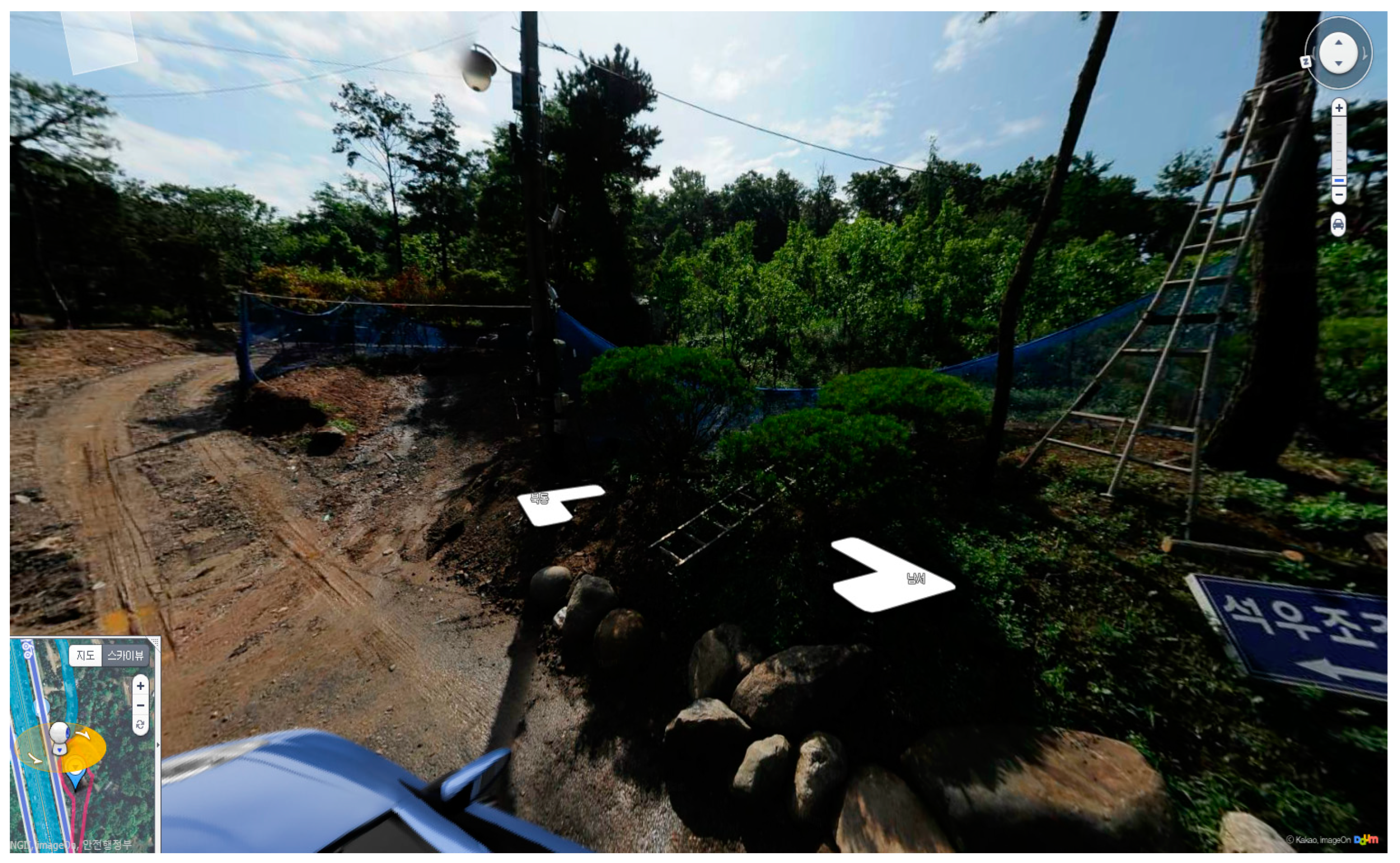
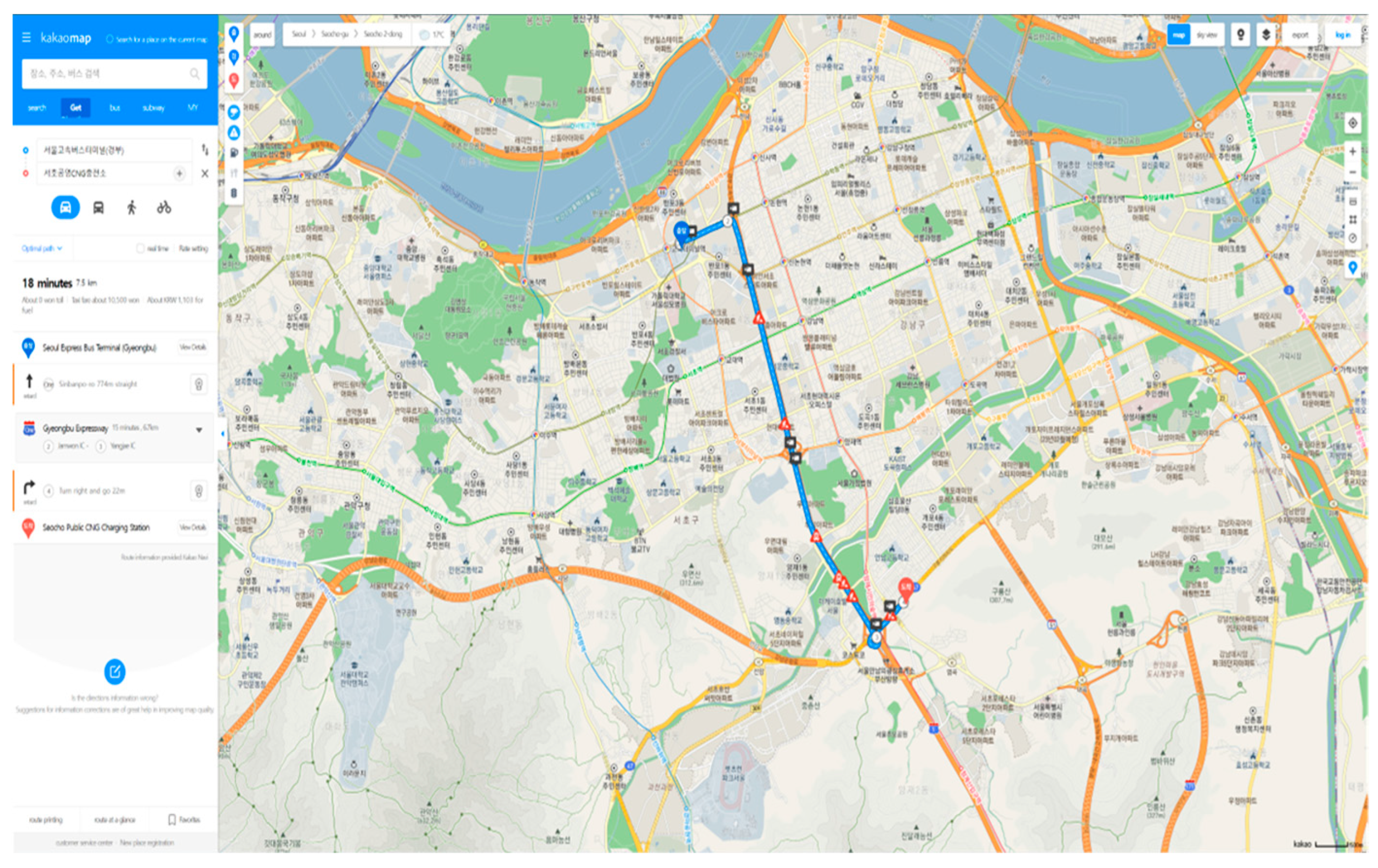

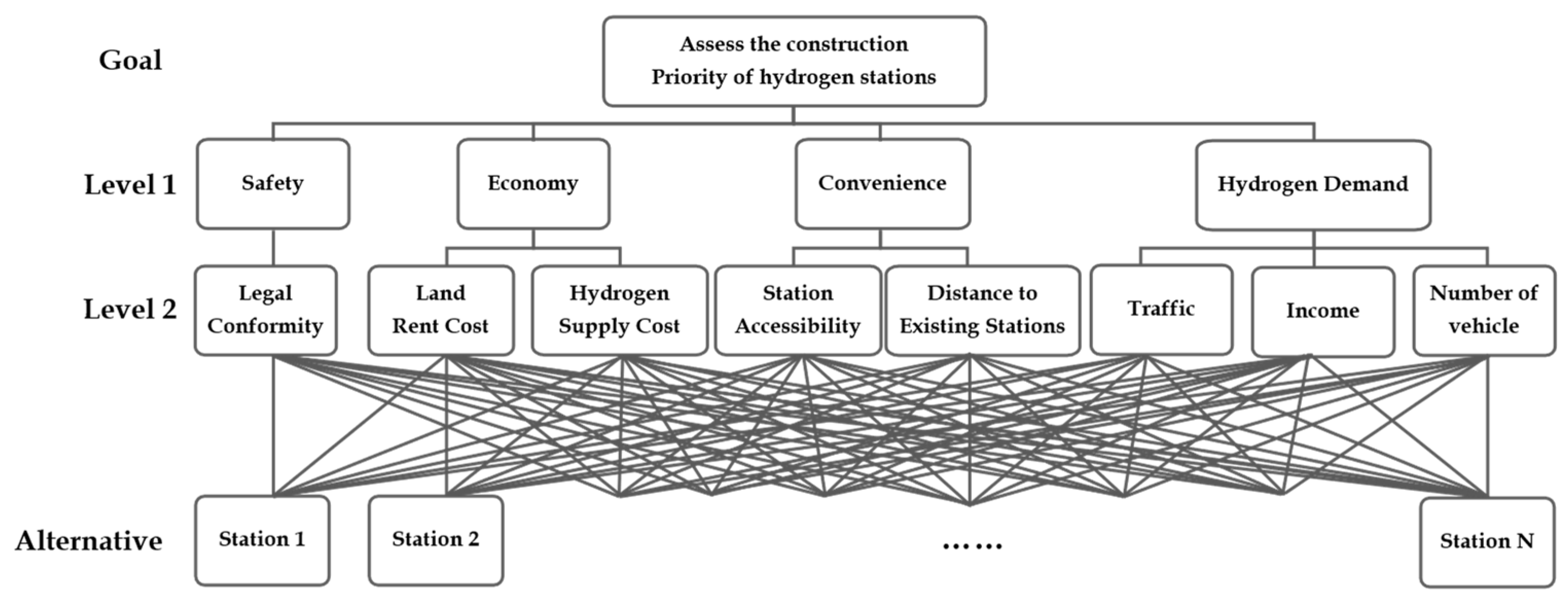
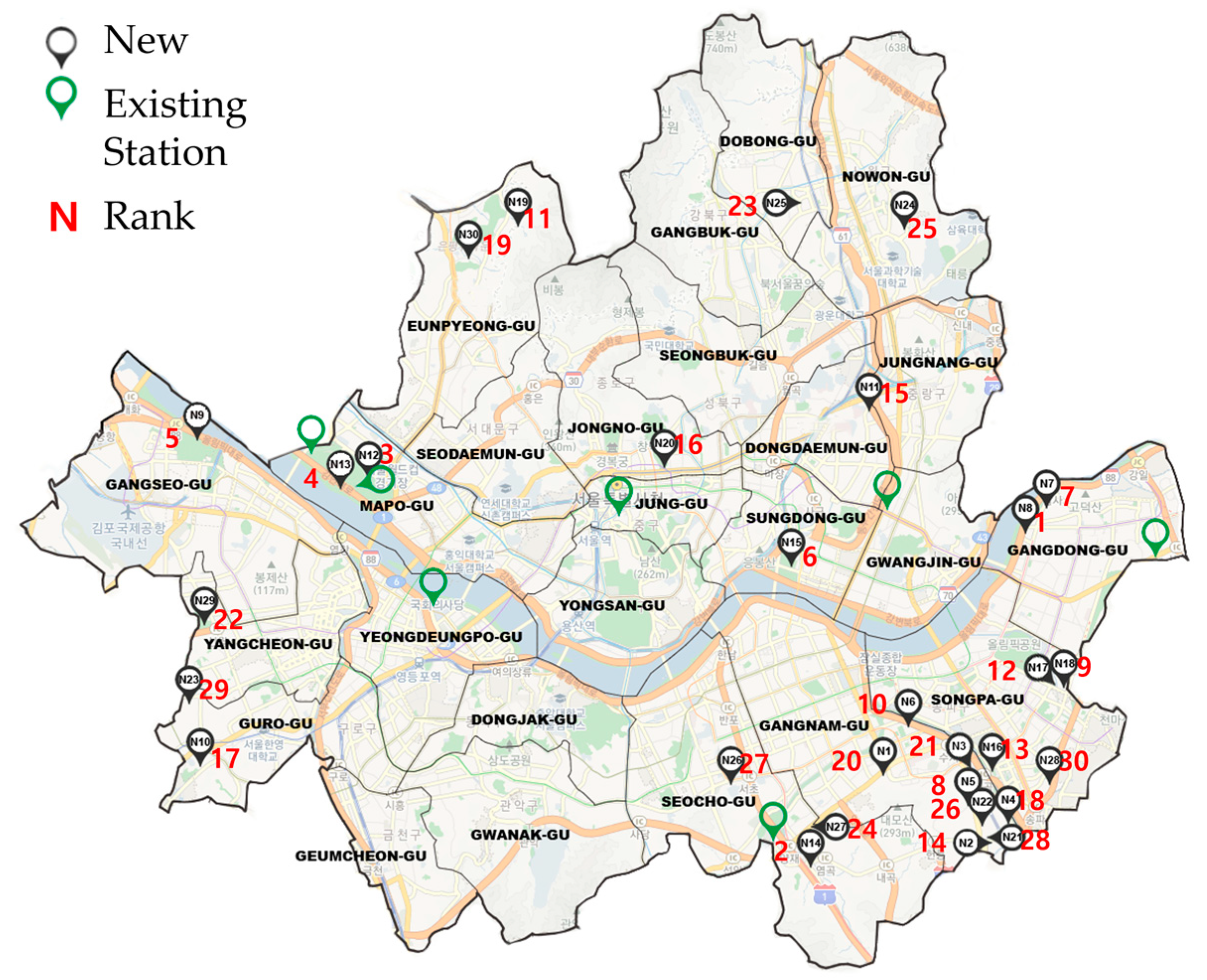
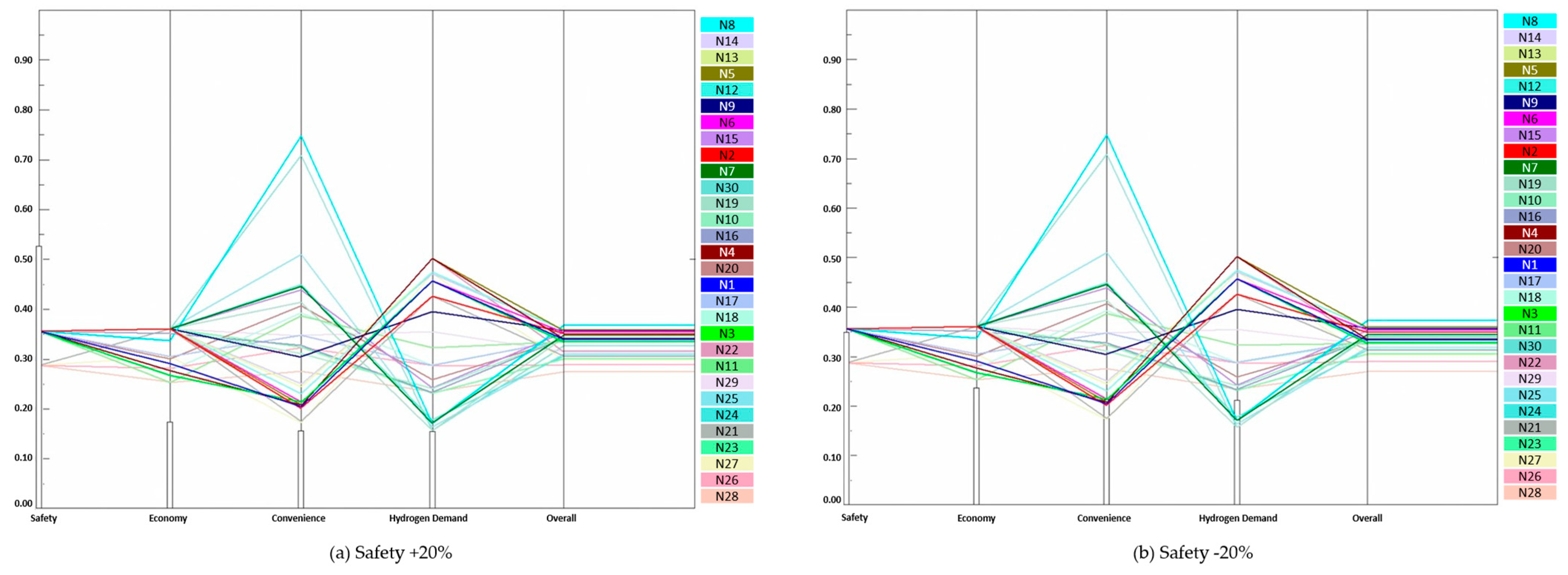
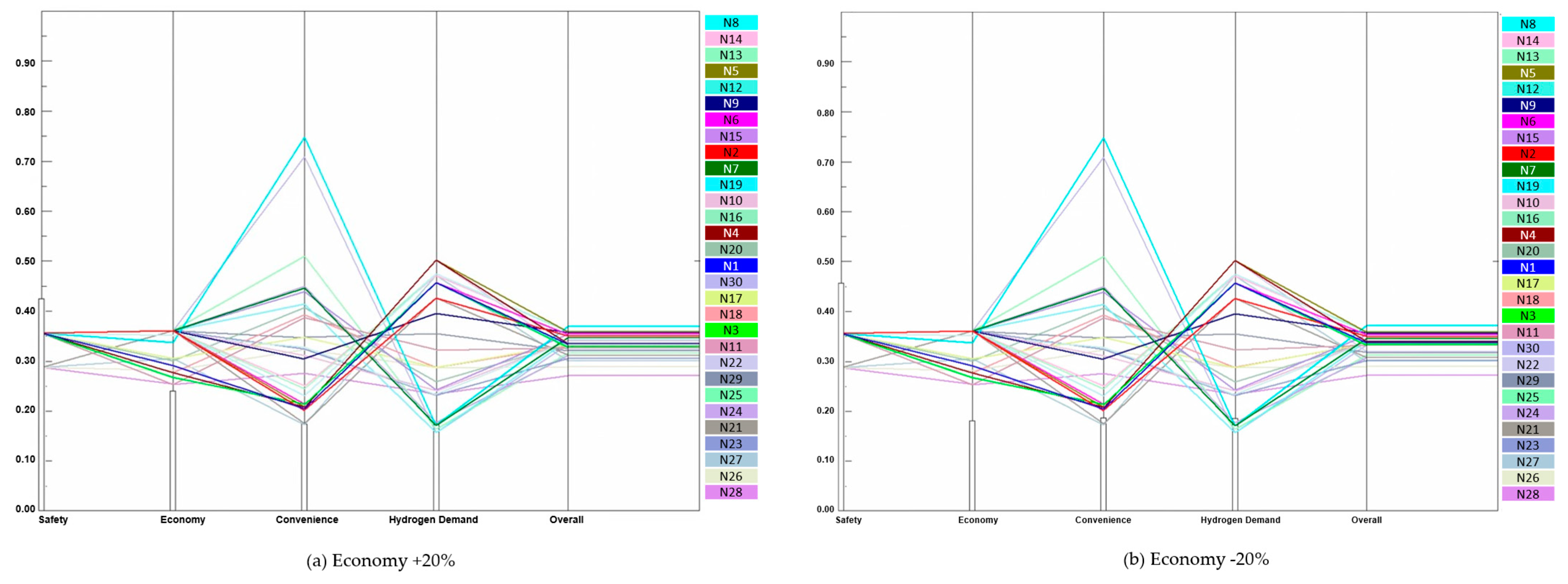

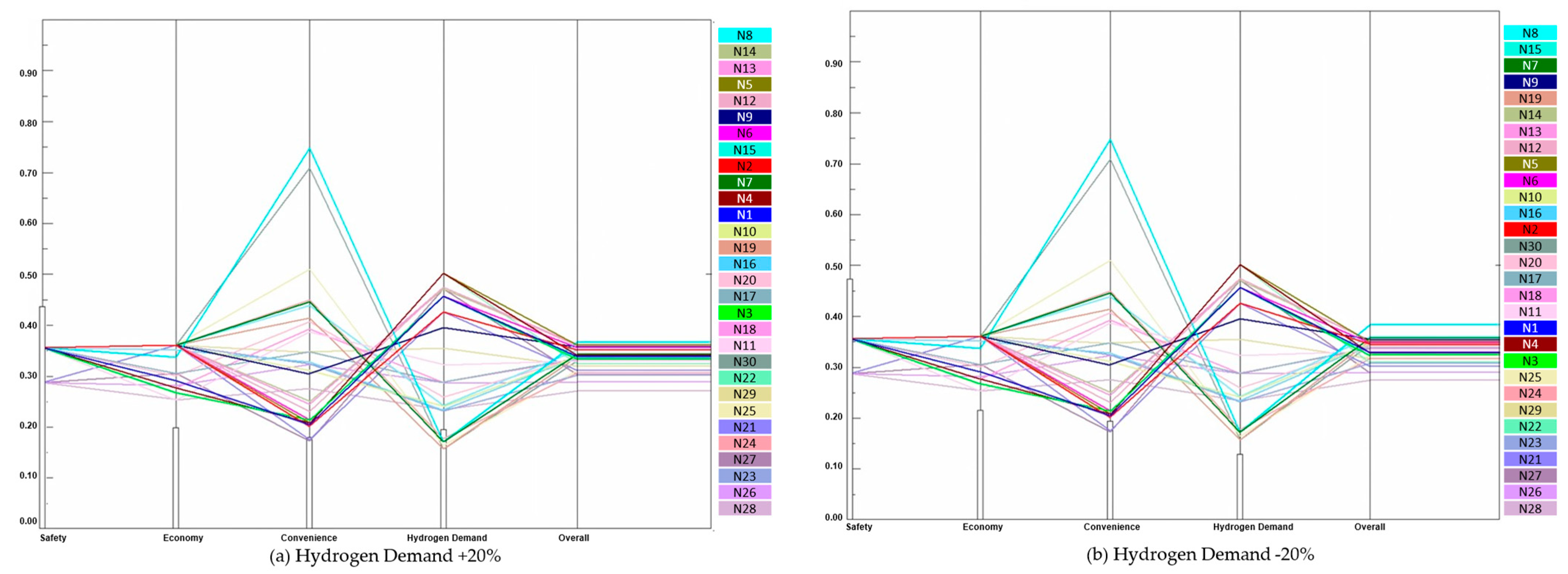
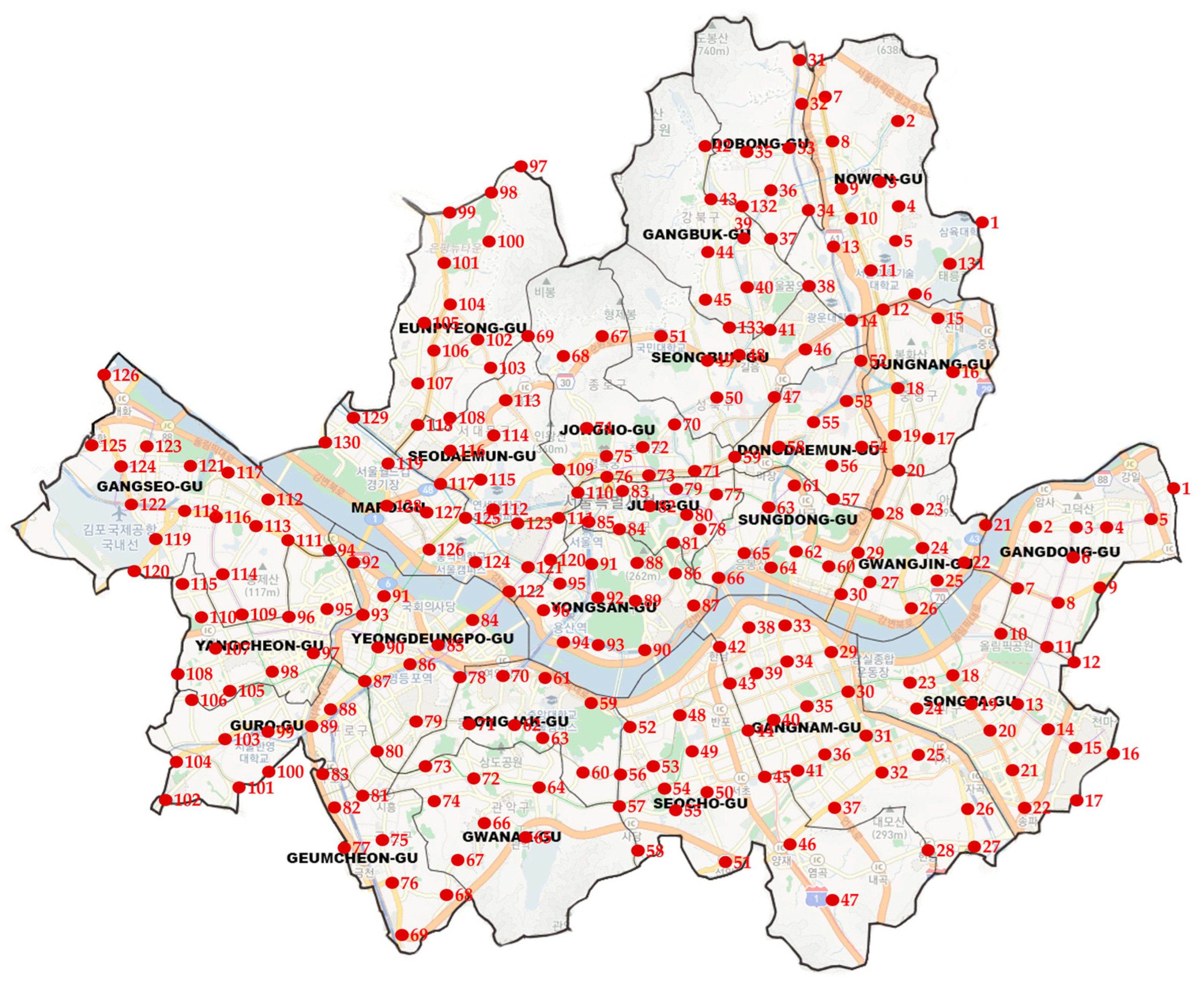
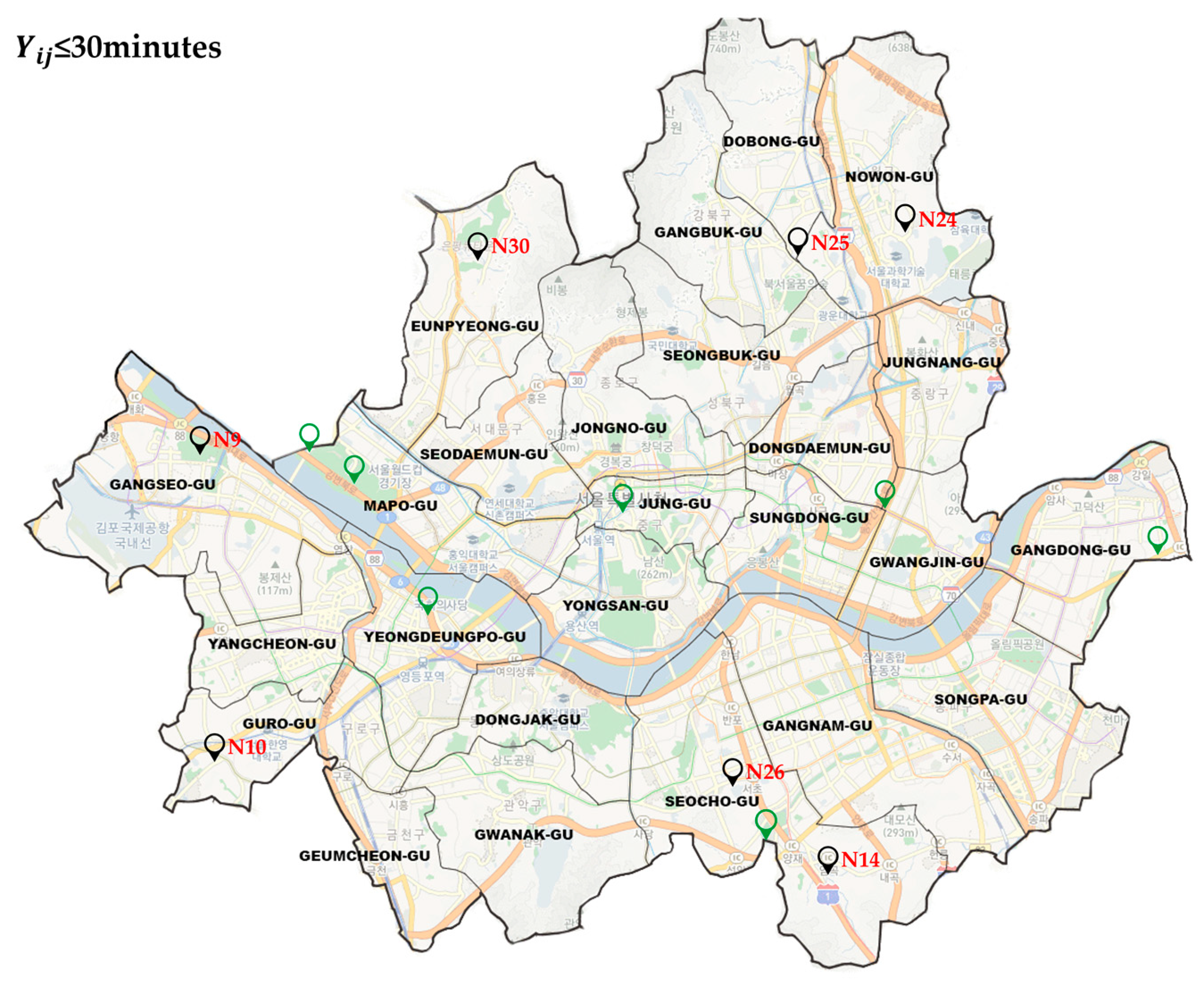
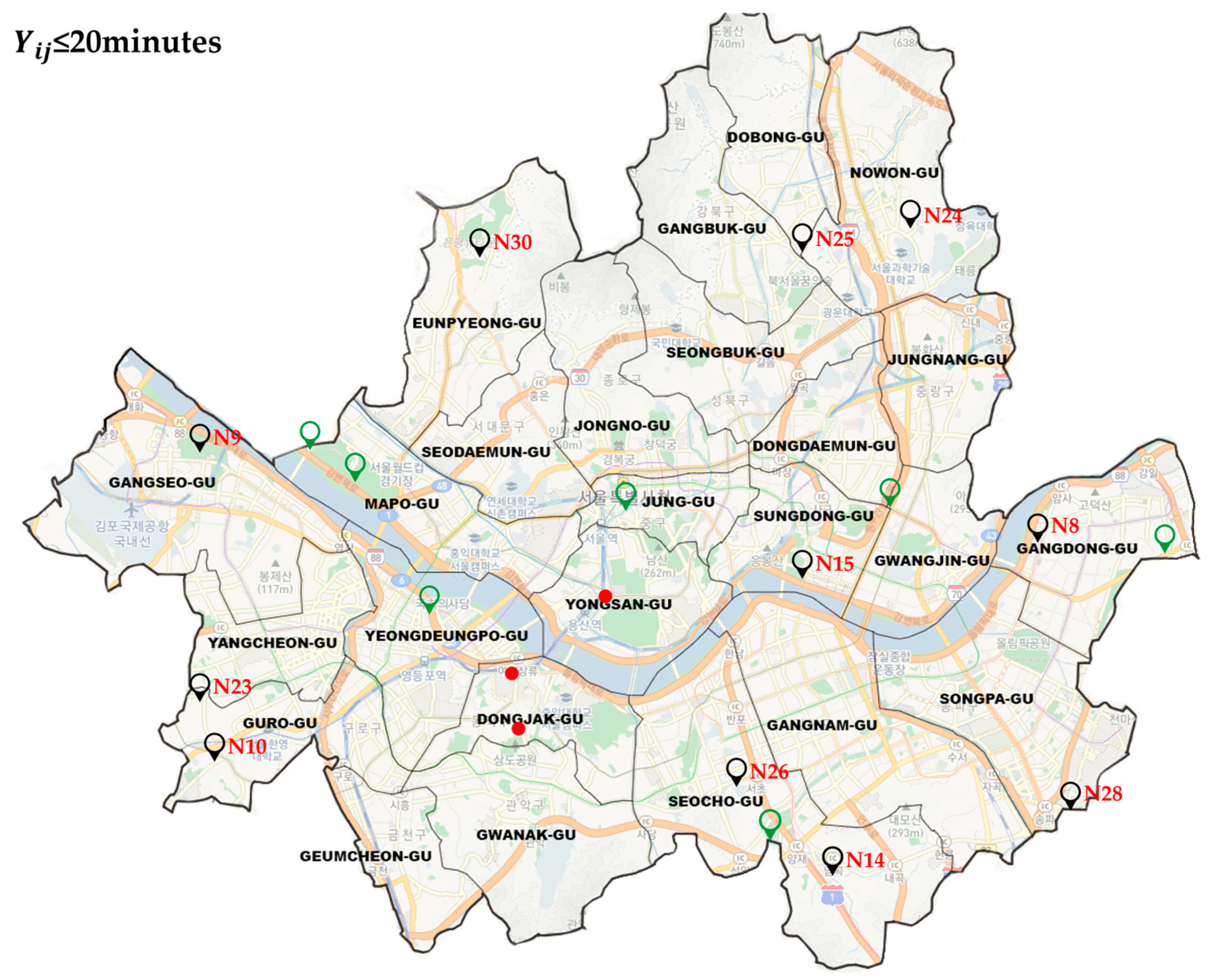
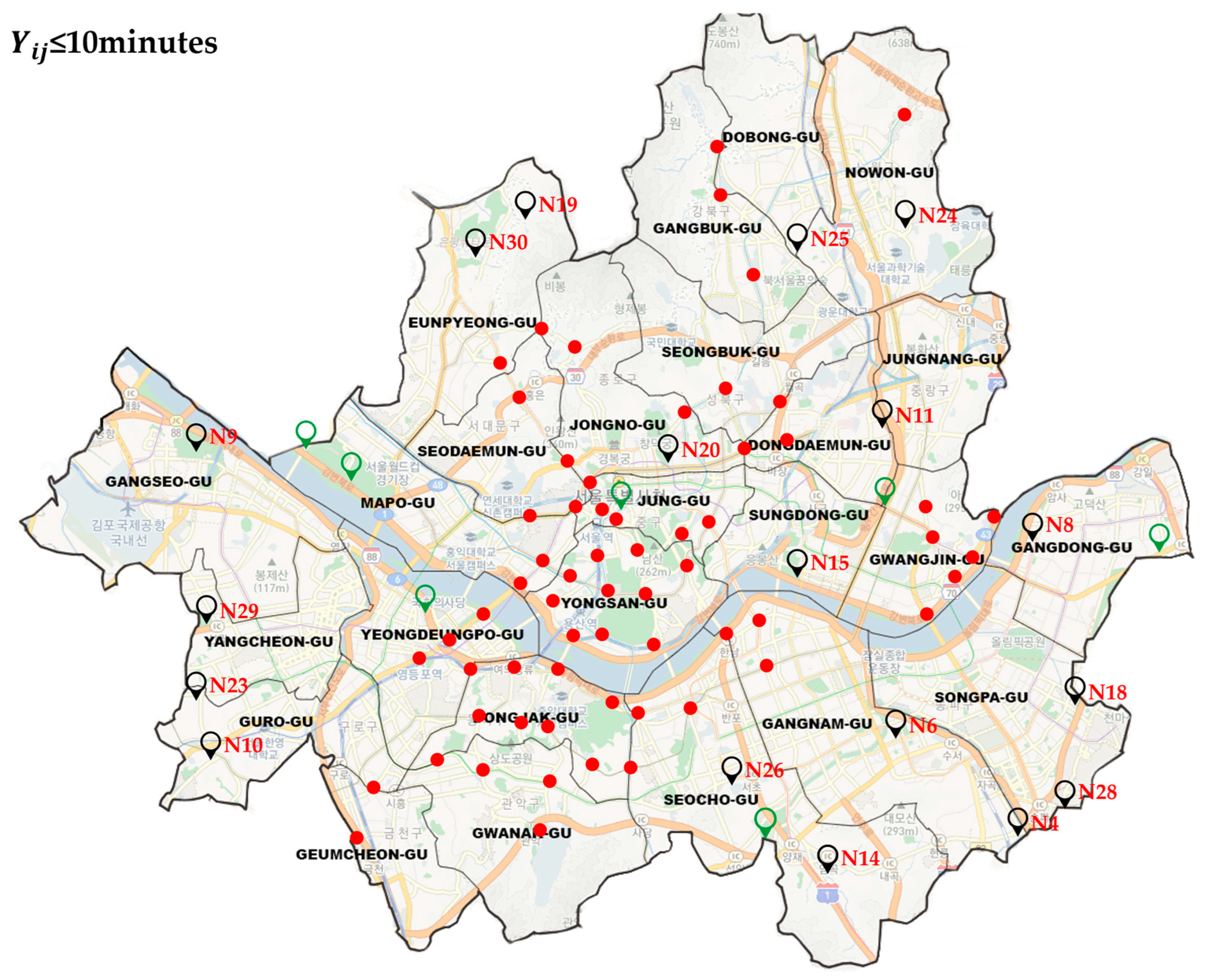
| Descriptive Evaluation | Quantification |
|---|---|
| extreme | 9 (9:1) |
| very strong | 7 (8:2) |
| strong | 5 (7:3) |
| moderate | 3 (6:4) |
| equal | 1 (5:5) |
| District (gu) | Population | Household | Land Area (km2) | Vehicles | Passenger Car | EV | HCEV | Average Salary Income (Million Won) |
|---|---|---|---|---|---|---|---|---|
| Gangnam | 534,103 | 232,777 | 40 | 247,356 | 226,343 | 12,176 | 196 | 3.55 |
| Gangdong | 464,037 | 202,169 | 25 | 152,865 | 133,027 | 1294 | 204 | 3.27 |
| Gangbuk | 297,702 | 144,313 | 24 | 75,252 | 63,165 | 514 | 24 | 2.2 |
| Gangseo | 574,638 | 273,697 | 41 | 206,968 | 178,730 | 1777 | 132 | 3.15 |
| Gwanak | 501,226 | 283,623 | 30 | 118,694 | 102,859 | 777 | 63 | 2.68 |
| Gwangjin | 351,252 | 169,291 | 17 | 98,644 | 83,994 | 623 | 47 | 2.59 |
| Guro | 418,418 | 183,655 | 20 | 147,448 | 124,837 | 3799 | 159 | 2.86 |
| Geumcheon | 242,818 | 119,583 | 13 | 91,398 | 74,340 | 561 | 36 | 2.84 |
| Nowon | 508,014 | 217,540 | 35 | 152,518 | 134,851 | 896 | 63 | 2.48 |
| Dobong | 313,989 | 138,356 | 21 | 95,734 | 81,651 | 639 | 26 | 2.2 |
| Dongdaemun | 353,601 | 169,873 | 14 | 99,130 | 83,552 | 659 | 54 | 2.82 |
| Dongjak | 390,432 | 185,773 | 16 | 106,295 | 95,087 | 726 | 92 | 3.08 |
| Mapo | 375,585 | 180,084 | 24 | 121,739 | 105,620 | 1087 | 143 | 3.1 |
| Seodaemun | 319,554 | 145,797 | 18 | 90,135 | 79,213 | 670 | 85 | 3.49 |
| Seocho | 408,451 | 167,749 | 47 | 176,437 | 156,015 | 3497 | 245 | 3.73 |
| Seongdong | 288,234 | 133,305 | 17 | 105,504 | 91,300 | 1461 | 51 | 3.04 |
| Seongbuk | 441,984 | 197,082 | 25 | 122,686 | 107,410 | 926 | 63 | 2.77 |
| Songpa | 664,514 | 284,853 | 34 | 250,031 | 213,370 | 1991 | 189 | 3.09 |
| Yangcheon | 444,010 | 181,187 | 17 | 151,651 | 132,101 | 998 | 86 | 2.76 |
| Yeongdeungpo | 398,085 | 188,832 | 25 | 144,662 | 120,956 | 2388 | 159 | 4.29 |
| Yongsan | 233,284 | 109,805 | 22 | 75,512 | 66,949 | 975 | 63 | 3.73 |
| Eunpyeong | 470,602 | 213,876 | 30 | 134,245 | 117,243 | 901 | 106 | 2.43 |
| Jongno | 152,211 | 72,524 | 24 | 50,105 | 41,333 | 612 | 72 | 4.48 |
| Jung | 130,785 | 63,139 | 10 | 59,351 | 48,604 | 968 | 38 | 4.14 |
| Jungnang | 390,140 | 187,413 | 19 | 115,748 | 96,362 | 778 | 47 | 2.46 |
| Seoul | 9,667,669 | 4,446,296 | 605 | 3,190,108 | 2,758,912 | 41,693 | 2443 | 3.09 |
| Korea | 51,430,018 | 23,716,980 | 100,432 | 25,556,066 | 20,999,380 | 390,403 | 29,689 | 3.2 |
| Types of Facilities | Separation Distance | Notion |
|---|---|---|
| Equipment inspection | 1 m | - |
| Safe explosion | 4.5 m | - |
| School’s borders | 200 m | - |
| Residential facilities | 25 m | Apartments, villas, houses under 19 households. |
| Playgrounds, Hospital, Daycare centers, and kindergartens | 50 m | - |
| railway | 30 m | Subway entrance, including outside of the station building |
| Number | Safety: Economy | Safety: Convenience | Safety: Hydrogen Demand | Economy: Convenience | Economy: Hydrogen Demand | Convenience: Hydrogen Demand |
|---|---|---|---|---|---|---|
| 1 | 0.2 | 1 | 1 | 7 | 5 | 0.33 |
| 2 | 0.14 | 5 | 0.33 | 7 | 5 | 0.33 |
| 3 | 5 | 7 | 9 | 3 | 5 | 0.33 |
| 4 | 7 | 5 | 5 | 1 | 3 | 0.33 |
| 5 | 5 | 7 | 7 | 0.33 | 0.33 | 1 |
| 6 | 7 | 9 | 9 | 0.2 | 0.2 | 1 |
| 7 | 0.33 | 3 | 5 | 7 | 7 | 0.33 |
| 8 | 3 | 0.14 | 0.2 | 0.14 | 0.2 | 5 |
| 9 | 3 | 3 | 1 | 0.33 | 1 | 1 |
| 10 | 3 | 5 | 5 | 0.33 | 0.33 | 1 |
| 11 | 0.2 | 0.2 | 0.2 | 1 | 0.33 | 1 |
| 12 | 7 | 7 | 7 | 5 | 5 | 1 |
| 13 | 9 | 9 | 9 | 3 | 3 | 1 |
| 14 | 7 | 7 | 5 | 1 | 0.33 | 0.33 |
| 15 | 9 | 9 | 9 | 0.33 | 0.33 | 1 |
| 16 | 5 | 3 | 5 | 1 | 1 | 3 |
| 17 | 9 | 9 | 9 | 0.2 | 1 | 5 |
| 18 | 9 | 7 | 7 | 0.2 | 0.2 | 1 |
| 19 | 5 | 5 | 7 | 3 | 3 | 1 |
| 20 | 0.2 | 0.14 | 3 | 0.33 | 3 | 5 |
| 21 | 0.33 | 0.33 | 0.33 | 1 | 1 | 3 |
| 22 | 0.2 | 0.33 | 0.2 | 3 | 1 | 1 |
| Geometric mean | 2.044 | 2.545 | 2.585 | 1.080 | 1.064 | 1.020 |
| Number | Land Rent Cost: Hydrogen Supply Cost | Station Accessibility: Distance to Existing Station | Traffic: Income | Traffic: Number of Vehicles | Income: Number of Vehicles |
|---|---|---|---|---|---|
| 1 | 0.2 | 5 | 0.14 | 1 | 0.14 |
| 2 | 0.14 | 7 | 7 | 0.33 | 0.11 |
| 3 | 0.14 | 3 | 5 | 1 | 0.33 |
| 4 | 0.2 | 0.2 | 0.33 | 1 | 3 |
| 5 | 0.2 | 5 | 1 | 5 | 5 |
| 6 | 0.2 | 5 | 1 | 0.33 | 0.33 |
| 7 | 5 | 0.33 | 1 | 5 | 5 |
| 8 | 0.2 | 5 | 5 | 0.14 | 0.11 |
| 9 | 0.33 | 1 | 5 | 5 | 1 |
| 10 | 0.2 | 0.14 | 5 | 5 | 0.33 |
| 11 | 0.33 | 1 | 1 | 0.33 | 1 |
| 12 | 7 | 7 | 5 | 5 | 0.33 |
| 13 | 0.33 | 3 | 7 | 7 | 0.33 |
| 14 | 5 | 3 | 5 | 5 | 1 |
| 15 | 0.14 | 5 | 3 | 1 | 0.2 |
| 16 | 3 | 7 | 0.33 | 1 | 3 |
| 17 | 1 | 5 | 7 | 1 | 0.14 |
| 18 | 0.2 | 7 | 5 | 5 | 3 |
| 19 | 0.33 | 5 | 5 | 5 | 1 |
| 20 | 0.2 | 5 | 5 | 3 | 0.33 |
| 21 | 1 | 7 | 7 | 0.2 | 0.14 |
| 22 | 0.33 | 0.33 | 5 | 3 | 3 |
| Geometric mean | 0.439 | 2.499 | 2.578 | 1.587 | 0.730 |
| Station Number | Legal Conformity | Land Rent Cost (won/3.3 m2) | Hydrogen Supply Cost (won/kg) | Station Accessibility (Minutes) | Distance to Existing Station (Minutes) | Traffic (Vehicles) | Income (10,000 Won/month) | Number of Vehicle (EV Vehicles) |
|---|---|---|---|---|---|---|---|---|
| N1 | A | 1090 | 8800 | 15 | 9 | 88,638 | 355 | 12,176 |
| N2 | A | 531 | 8800 | 21 | 14 | 66,463 | 355 | 12,176 |
| N3 | A | 1367 | 8800 | 18 | 13 | 88,638 | 355 | 12,176 |
| N4 | A | 1260 | 8800 | 19 | 14 | 116,956 | 355 | 12,176 |
| N5 | A | 570 | 8800 | 20 | 14 | 116,956 | 355 | 12,176 |
| N6 | A | 416 | 8800 | 18 | 13 | 88,638 | 355 | 12,176 |
| N7 | A | 590 | 8800 | 8 | 25 | 30,679 | 327 | 1294 |
| N8 | A | 770 | 8800 | 4 | 28 | 30,679 | 327 | 1294 |
| N9 | A | 245 | 8800 | 9 | 8 | 174,491 | 315 | 1777 |
| N10 | A | 127 | 8800 | 19 | 30 | 54,732 | 286 | 3799 |
| N11 | A | 1634 | 8800 | 11 | 28 | 146,317 | 282 | 659 |
| N12 | A | 280 | 8800 | 11 | 4 | 237,956 | 310 | 1087 |
| N13 | A | 315 | 8800 | 13 | 11 | 237,956 | 310 | 1087 |
| N14 | A | 228 | 8800 | 10 | 4 | 192,316 | 373 | 3497 |
| N15 | A | 650 | 8800 | 8 | 24 | 78,989 | 304 | 1461 |
| N16 | A | 710 | 8800 | 10 | 16 | 67,273 | 309 | 1991 |
| N17 | A | 990 | 8800 | 11 | 22 | 102,628 | 309 | 1991 |
| N18 | A | 1270 | 8800 | 9 | 22 | 102,628 | 309 | 1991 |
| N19 | A | 230 | 8800 | 9 | 25 | 42,373 | 243 | 901 |
| N20 | A | 1020 | 8800 | 9 | 24 | 69,224 | 448 | 612 |
| N21 | B | 175 | 8800 | 23 | 12 | 66,463 | 355 | 12,176 |
| N22 | B | 175 | 8800 | 20 | 14 | 116,956 | 355 | 12,176 |
| N23 | B | 109 | 8800 | 14 | 25 | 48,117 | 286 | 3799 |
| N24 | B | 45 | 8800 | 9 | 31 | 60,341 | 248 | 896 |
| N25 | B | 376 | 8800 | 8 | 35 | 53,892 | 220 | 639 |
| N26 | B | 1200 | 8800 | 8 | 6 | 68,057 | 373 | 3497 |
| N27 | B | 992 | 8800 | 15 | 4 | 192,316 | 373 | 3497 |
| N28 | B | 1690 | 8800 | 15 | 20 | 67,273 | 309 | 1991 |
| N29 | B | 505 | 8800 | 16 | 32 | 166,143 | 276 | 998 |
| N30 | B | 624 | 8800 | 4 | 22 | 42,373 | 243 | 901 |
| Station Number | Legal Conformity | Land Rent Cost (won/3.3 m2) | Hydrogen Supply Cost (won/kg) | Station Accessibility (Minutes) | Distance to Existing Station (Minutes) | Traffic (Vehicles) | Income (10,000 Won/month) | Number of Vehicle (EV Vehicles) |
|---|---|---|---|---|---|---|---|---|
| N1 | 100 | 62 | 100 | 27 | 26 | 37 | 79 | 100 |
| N2 | 100 | 100 | 100 | 19 | 40 | 28 | 79 | 100 |
| N3 | 100 | 49 | 100 | 22 | 37 | 37 | 79 | 100 |
| N4 | 100 | 53 | 100 | 21 | 40 | 49 | 79 | 100 |
| N5 | 100 | 100 | 100 | 20 | 40 | 49 | 79 | 100 |
| N6 | 100 | 100 | 100 | 22 | 37 | 37 | 79 | 100 |
| N7 | 100 | 100 | 100 | 50 | 71 | 13 | 73 | 11 |
| N8 | 100 | 87 | 100 | 100 | 80 | 13 | 73 | 11 |
| N9 | 100 | 100 | 100 | 44 | 23 | 73 | 70 | 15 |
| N10 | 100 | 100 | 100 | 21 | 86 | 23 | 64 | 31 |
| N11 | 100 | 41 | 100 | 36 | 80 | 61 | 63 | 5 |
| N12 | 100 | 100 | 100 | 36 | 11 | 100 | 69 | 9 |
| N13 | 100 | 100 | 100 | 31 | 31 | 100 | 69 | 9 |
| N14 | 100 | 100 | 100 | 40 | 11 | 81 | 83 | 29 |
| N15 | 100 | 100 | 100 | 50 | 69 | 33 | 68 | 12 |
| N16 | 100 | 95 | 100 | 40 | 46 | 28 | 69 | 16 |
| N17 | 100 | 68 | 100 | 36 | 63 | 43 | 69 | 16 |
| N18 | 100 | 53 | 100 | 44 | 63 | 43 | 69 | 16 |
| N19 | 100 | 100 | 100 | 44 | 71 | 18 | 54 | 7 |
| N20 | 100 | 66 | 100 | 44 | 69 | 29 | 100 | 5 |
| N21 | 80 | 100 | 100 | 17 | 34 | 28 | 79 | 100 |
| N22 | 80 | 100 | 100 | 20 | 40 | 49 | 79 | 100 |
| N23 | 80 | 100 | 100 | 29 | 71 | 20 | 64 | 31 |
| N24 | 80 | 100 | 100 | 44 | 89 | 25 | 55 | 7 |
| N25 | 80 | 100 | 100 | 50 | 100 | 23 | 49 | 5 |
| N26 | 80 | 56 | 100 | 50 | 17 | 29 | 83 | 29 |
| N27 | 80 | 68 | 100 | 27 | 11 | 81 | 83 | 29 |
| N28 | 80 | 40 | 100 | 27 | 57 | 28 | 69 | 16 |
| N29 | 80 | 100 | 100 | 25 | 91 | 70 | 62 | 8 |
| N30 | 80 | 100 | 100 | 100 | 63 | 18 | 54 | 7 |
| Rank | Station Number | Location Criteria Hangang | Legal Conformity | Land Rent Cost | Hydrogen Supply Cost | Station Accessibility | Distance to Existing Station | Traffic | Income | Number of Vehicle | Total Score |
|---|---|---|---|---|---|---|---|---|---|---|---|
| 1 | N8 | South | 100 | 74 | 100 | 100 | 80 | 13 | 73 | 11 | 84.0 |
| 2 | N14 | South | 100 | 100 | 100 | 40 | 11 | 81 | 83 | 29 | 81.8 |
| 3 | N13 | North | 100 | 100 | 100 | 31 | 31 | 100 | 69 | 9 | 81.8 |
| 4 | N12 | North | 100 | 100 | 100 | 36 | 11 | 100 | 69 | 9 | 81.5 |
| 5 | N5 | South | 100 | 99 | 100 | 20 | 40 | 49 | 79 | 100 | 81.2 |
| 6 | N9 | South | 100 | 100 | 100 | 44 | 23 | 73 | 70 | 15 | 81.1 |
| 7 | N6 | South | 100 | 100 | 100 | 22 | 37 | 37 | 79 | 100 | 80.3 |
| 8 | N15 | North | 100 | 87 | 100 | 50 | 69 | 33 | 68 | 12 | 79.5 |
| 9 | N2 | South | 100 | 100 | 100 | 19 | 40 | 28 | 79 | 100 | 79.2 |
| 10 | N7 | South | 100 | 96 | 100 | 50 | 71 | 13 | 73 | 11 | 78.4 |
| 11 | N4 | South | 100 | 45 | 100 | 21 | 40 | 49 | 79 | 100 | 78.0 |
| 12 | N19 | North | 100 | 100 | 100 | 44 | 71 | 18 | 54 | 7 | 77.5 |
| 13 | N20 | North | 100 | 55 | 100 | 44 | 69 | 29 | 100 | 5 | 77.4 |
| 14 | N1 | South | 100 | 52 | 100 | 27 | 26 | 37 | 79 | 100 | 77.4 |
| 15 | N10 | South | 100 | 100 | 100 | 21 | 86 | 23 | 64 | 31 | 77.2 |
| 16 | N11 | North | 100 | 35 | 100 | 36 | 80 | 61 | 63 | 5 | 77.1 |
| 17 | N18 | South | 100 | 45 | 100 | 44 | 63 | 43 | 69 | 16 | 77.1 |
| 18 | N17 | South | 100 | 57 | 100 | 36 | 63 | 43 | 69 | 16 | 76.8 |
| 19 | N3 | South | 100 | 41 | 100 | 22 | 37 | 37 | 79 | 100 | 76.8 |
| 20 | N16 | South | 100 | 80 | 100 | 40 | 46 | 28 | 69 | 16 | 76.4 |
| 21 | N30 | North | 80 | 91 | 100 | 100 | 63 | 18 | 54 | 7 | 74.9 |
| 22 | N22 | South | 80 | 100 | 100 | 20 | 40 | 49 | 79 | 100 | 72.4 |
| 23 | N29 | South | 80 | 100 | 100 | 25 | 91 | 70 | 62 | 8 | 72.2 |
| 24 | N25 | North | 80 | 100 | 100 | 50 | 100 | 23 | 49 | 5 | 71.0 |
| 25 | N24 | North | 80 | 100 | 100 | 44 | 89 | 25 | 55 | 7 | 70.3 |
| 26 | N21 | South | 80 | 100 | 100 | 17 | 34 | 28 | 79 | 100 | 69.9 |
| 27 | N27 | South | 80 | 57 | 100 | 27 | 11 | 81 | 83 | 29 | 68.7 |
| 28 | N23 | South | 80 | 100 | 100 | 29 | 71 | 20 | 64 | 31 | 68.4 |
| 29 | N26 | South | 80 | 47 | 100 | 50 | 17 | 29 | 83 | 29 | 66.7 |
| 30 | N28 | South | 80 | 33 | 100 | 27 | 57 | 28 | 69 | 16 | 63.7 |
| Criteria | Sensitivity | Safety | Economy | Convenience | Hydrogen Demand | Total |
|---|---|---|---|---|---|---|
| Safety | +20% | 0.528 | 0.169 | 0.152 | 0.151 | 1.000 |
| −20% | 0.352 | 0.232 | 0.209 | 0.207 | 1.000 | |
| Economy | +20% | 0.420 | 0.240 | 0.171 | 0.169 | 1.000 |
| −20% | 0.464 | 0.160 | 0.189 | 0.187 | 1.000 | |
| Convenience | +20% | 0.422 | 0.191 | 0.216 | 0.171 | 1.000 |
| −20% | 0.462 | 0.208 | 0.144 | 0.186 | 1.000 | |
| Hydrogen demand | +20% | 0.422 | 0.191 | 0.171 | 0.216 | 1.000 |
| −20% | 0.462 | 0.208 | 0.186 | 0.144 | 1.000 |
| Criteria | Sensitivity | Legal Conformity | Land Rent Cost | Hydrogen Supply Cost | Station Accessibility | Distance to Existing Station | Traffic | Income | Number of Vehicle |
|---|---|---|---|---|---|---|---|---|---|
| Safety | +20% | 0.53 | 0.05 | 0.12 | 0.11 | 0.04 | 0.08 | 0.03 | 0.04 |
| −20% | 0.35 | 0.07 | 0.16 | 0.15 | 0.06 | 0.10 | 0.04 | 0.06 | |
| Economy | +20% | 0.42 | 0.07 | 0.17 | 0.12 | 0.05 | 0.08 | 0.03 | 0.05 |
| −20% | 0.46 | 0.05 | 0.11 | 0.13 | 0.05 | 0.09 | 0.04 | 0.06 | |
| Convenience | +20% | 0.42 | 0.06 | 0.13 | 0.15 | 0.06 | 0.09 | 0.04 | 0.05 |
| −20% | 0.46 | 0.06 | 0.14 | 0.10 | 0.04 | 0.09 | 0.04 | 0.06 | |
| Hydrogen demand | +20% | 0.42 | 0.06 | 0.13 | 0.12 | 0.05 | 0.11 | 0.04 | 0.06 |
| −20% | 0.46 | 0.06 | 0.14 | 0.13 | 0.05 | 0.07 | 0.03 | 0.04 |
Disclaimer/Publisher’s Note: The statements, opinions and data contained in all publications are solely those of the individual author(s) and contributor(s) and not of MDPI and/or the editor(s). MDPI and/or the editor(s) disclaim responsibility for any injury to people or property resulting from any ideas, methods, instructions or products referred to in the content. |
© 2023 by the authors. Licensee MDPI, Basel, Switzerland. This article is an open access article distributed under the terms and conditions of the Creative Commons Attribution (CC BY) license (https://creativecommons.org/licenses/by/4.0/).
Share and Cite
Kim, K.R.; Cho, J.H. Prioritization and Optimal Location of Hydrogen Fueling Stations in Seoul: Using Multi-Standard Decision-Making and ILP Optimization. Processes 2023, 11, 831. https://doi.org/10.3390/pr11030831
Kim KR, Cho JH. Prioritization and Optimal Location of Hydrogen Fueling Stations in Seoul: Using Multi-Standard Decision-Making and ILP Optimization. Processes. 2023; 11(3):831. https://doi.org/10.3390/pr11030831
Chicago/Turabian StyleKim, Kyeong Ryong, and Jae Hyung Cho. 2023. "Prioritization and Optimal Location of Hydrogen Fueling Stations in Seoul: Using Multi-Standard Decision-Making and ILP Optimization" Processes 11, no. 3: 831. https://doi.org/10.3390/pr11030831






